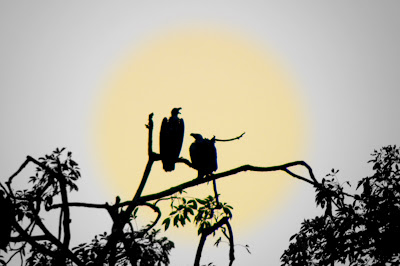Thursday, November 19, 2009
White backed vultures spotted in Katernia.
Katernia ghat wildlife sanctuary is host to a flock of around hundred white backed vultures.This is another success story in the proud history of conservation efforts by the staff of the sanctuary.
White backed vultures [Gyps bengalensis]are in the IUCN Red List critically endangered species.This species, as well as the Indian and Slender-billed Vultures have suffered a 99 percent population decrease in India and nearby countries since the early 1990s. The decline has been widely attributed to poisoning by diclofenac, which is used as veterinary non-steroidal anti-inflammatory drug , leaving traces in cattle carcasses which when fed on leads to kidney failure in birds.
When the population of this birds are declining on a rapid pace in the country katernia is rewriting the vulture conservation story, here they are thriving and are in good health whose perfect indicator is that they are breeding in the sanctuary.
Once they were a common sight in the whole of country but now they are spotted in isolated pockets.The major cause is in discriminate use of diclofenac by the livestock owners.In Katernia the socio economic status of the forest dwellers has been a major factor in the survival of this species.As per sanctuary officials the livestock owners in the villages are economically so weak that they are not even able to afford diclofenac for the treatment of their animals hence when they die their carcasses don't have traces of the drug hence reducing the risk to the vultures.Apart from this various steps have been taken by the park officials which include regular monitoring of the nesting sites of the vultures on the banks of Girwa.Sensitising the local population on the importance of vulture conservation.Advising the local veterinary drug sellers to not to stock diclofenac and informing the that the sale of the drug has been banned by the government, informing them about the substitute drug Meloxicam which has been tested to be safe for vultures and other scavenging birds.
All this has immensely contributed to the conservation of vultures in the sanctuary and i was informed that apart from white backed vulture the sactuary also has population of slender/long billed vultures and is also host to a migratory vulture [King Vulture] during the winter season.
Subscribe to:
Post Comments (Atom)




No comments:
Post a Comment